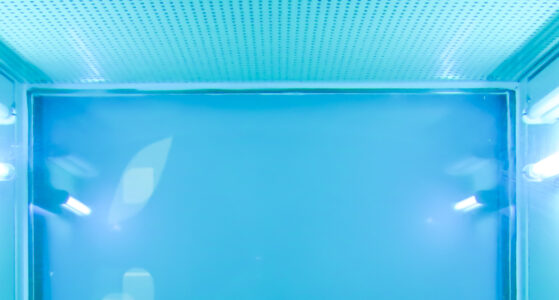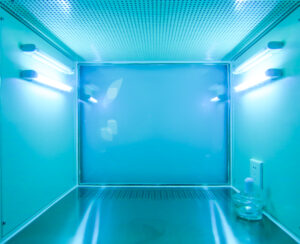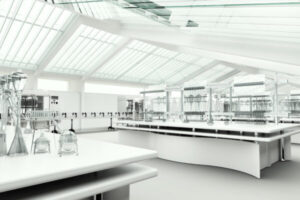UV Light Disinfection: Over a Century of Proven Results
UV light has been proven to have powerful germicidal benefits, dating back to the late 19th century when Downes & Blunt conducted the first scientific study in 1877 showing the effectiveness of UV light disinfection. As detailed in the public health report, The History of Ultraviolet Germicidal Irradiation for Air Disinfection, it would take many decades for science and medicine to further research and understand the powerful benefits of UV light for disinfection.
Niels Finsen won the Nobel Prize Award in Physiology or Medicine in 1903 for his contribution to the treatment of diseases with concentrated UV light. During the 1930s, William Wells demonstrated the ability of UV germicidal irradiation to prevent the spread of airborne diseases.
Despite these early proven successes of UV light for disinfection, interest in medical uses and further research of UV light waned until the 1980s, spurred partly by the increase in tuberculosis (TB). According to the World Health Organization, tuberculosis is the leading cause of adult deaths from a single infectious agent, with a fatality rate of about 23%. UV germicidal lamps are proven highly effective at eliminating tuberculosis when used in wall-mounted, upper-room UVGI air purification systems, according to the Rensselaer Polytechnic Institute, Lighting Research Center, Controlling Tuberculosis Transmission with Ultraviolet Irradiation.
Effectiveness of UV Light Germicidal Disinfection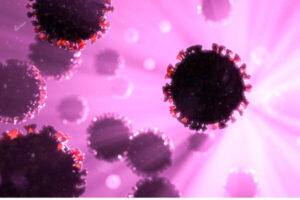
Ultraviolet radiation delivers maximum germicidal effectiveness to inactivate microorganisms when emitted at the optimal wavelength of 253.7 nanometer (nm), referred to as Ultraviolet germicidal irradiation (UVGI). Germicidal effectiveness decreases when emitted at other than optimal wavelengths. This is why high-quality UV disinfection lamps are so important, to effectively deliver the right amount of UV radiation for the desired application.
UV light disinfection effectively inactivates microorganisms by damaging the DNA of cells. DNA is responsible for cell replication, thus damaging the structure of the DNA renders cells unable to replicate and unable to spread disease. The UV photons are absorbed by the cell, creating pyrimidine dimers. This causes two adjacent thymine or cytosine bases to bond with each other instead of across the double helix as usual.
A DNA molecule with pyrimidine dimers is unable to function properly, resulting in the organism’s death or inability to replicate. An organism that cannot reproduce is no longer capable of spreading disease.
Quality Lamps Key to Effective UV Light Disinfection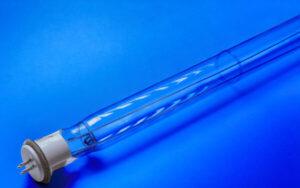
The ultraviolet radiation engineers at LightSources understand the technology behind ultraviolet light and how to harness the maximum, most optimal nanometer in a wide range of UV disinfection lamp products. We develop custom, proprietary UV lamp solutions to meet your required germicidal specifications in any application. UV disinfection lamps by LightSources can be found worldwide in air, surface, and water disinfection applications, providing long-lasting, powerful germicidal effectiveness.
As global leaders in germicidal UVC technologies, LightSources and our strategic partner, LightTech, offer OEMs the widest range of standard and highly customized UVC lamps and components available. Our innovative lamps offer safe, effective, and affordable solutions in countless industrial applications while at the same time allowing OEMs to comply with strict local codes and FDA safety regulations.
Measuring UV Dose, Fluence, and Irradiance 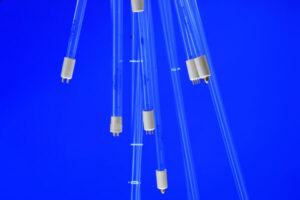
LightSources will design, engineer, and manufacture the UV disinfection lamp that meets your exact specifications with the optimal fluence, or UV dose, as required for your application. The UV dose is a product of UV irradiance (μW/cm2) x the specific exposure time in seconds to a given microorganism.
Irradiance and fluence rate are used interchangeably as they are virtually identical in a collimated beam apparatus. Fluence is the proper term to use over “UV dose” and is measured as millijoules per square centimeter (mJ/cm2).
The effective UV dose, or fluence, varies for different forms of bacteria and viruses, with some pathogens requiring a longer exposure time than others. Our engineers will recommend the right lamps for optimal UV light disinfection to meet your needs with a wide selection of high-quality UV lamps proven to outlast and outperform comparable lamps.
Our standard UVC germicidal lamps include:
- Low-pressure mercury lamps
- Low-pressure amalgam lams
- MPUV technology
- Quartz sleeves
- Electronic ballasts
Many proprietary technologies are available in each lamp design to provide longer-lasting, high-performance. LightSources also provides OEMs with custom lamp components and phosphor blends to meet your needs with quick turn-around time on prototypes and production. All manufacturing follows strict quality procedures as part of our ISO9001:2015 certification.
LightSources and our strategic partner LightTech, offer OEMs several advantages with on-time delivery of high-quality lamps and the benefit of high germicidal effectiveness through longer-lasting end-of-life performance. We provide UV light disinfection solutions with lamps designed for any industry or application.
Benefits of UV Light for Disinfection
UV light disinfection is an environmentally friendly method of killing bacteria, mold, fungi, and viruses without the use of harmful chemicals and does not produce corrosive materials or disinfection by-products (DBPs). There are many industries where surface disinfection without the use of chemicals is critical, and UV light disinfection can provide a safe, effective solution. UV disinfection systems are proven to be:
- Highly effective
- Cost-efficient
- Low maintenance
- Chemical free
UV lamps are used in a multitude of industries and applications, providing vital solutions to improve the health and wellness of people in residential, commercial, and industrial settings. It is used to disinfect the air of transmissible agents, fungi, bacteria, viruses, dust mites, and spores.
UV Disinfection Improves Health in Many Industries
UV light disinfection systems are proven to improve the health and wellness of people in many industries and environments. UV disinfection protects people against harmful bacteria, viruses, mold, and other pathogens in these many industries and applications:
Food Industry
UV lamps are used for irradiation. Ultraviolet light disinfection kills viruses, bacteria, yeast, and fungi in seconds and can also extend shelf life and nutritional value. Food applications include packaging materials, conveyor belts, transport containers, working surfaces, countertops, and on liquid-sugar tanks to kill mold and bacteria.
UV Hormesis
A promising new development is a process that helps to reduce post-harvest losses by delaying the ripening of fruits and vegetables. The technology offers the potential to save a great deal of money in the future.
Residential Air Purification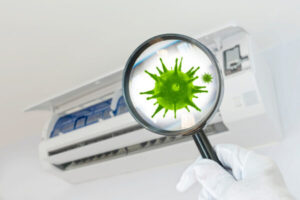
According to Chapter 62 of the ASHRAE handbook, Ultraviolet Air and Surface Treatment, the design objective for in-duct UV light disinfection is to uniformly distribute UV energy in all directions throughout the length of the duct or air-handling unit (AHU). This delivers the appropriate amount of UV dose to air moving through the irradiated zone. Enhancing the reflectivity of the air handling unit’s interior with materials such as aluminum can also improve the UVGI performance as reflecting UVC energy back into the irradiated zone increases the effective UV dose.
The American Society of Heating, Refrigerating, and Air-Conditioning Engineers, ASHRAE, also states that UV light disinfection systems are able to maintain the cleanliness of cooling coil surfaces and condensate pans when installed close to the equipment. The irradiance of in-duct systems should be in the range of 1,000 to 10,000 μW/cm2, although could be lower or higher depending on the application requirements. In-duct air disinfection systems should be designed for worst-case conditions.
Air Purification in Healthcare 
A study by Avinash Kulkarni (PhD), Aeropure UV Systems Pvt Ltd, INDIA, examined both Tier 1 and Tier 2 types of UV air purification systems in health care facilities. Tier 1 systems are considered UVGI on Cooling Coils in AHU, whereas Tier 2 systems are defined as localized Upper Room UVGI. Studies have repeatedly shown a reduction in bacteria count of 70% to 80% for both Tier 1 and Tier 2 systems.
UV germicidal technology is especially important in hospitals and other settings where it is integrated into air conditioning systems to disinfect pathogens that cause illnesses and contaminants that can aggravate respiratory conditions.
Industrial Air Purification
UV lamps are used to remove harmful or toxic chemicals produced in many industries and to reduce or eliminate VOCs and industrial exhausts containing solvents.
Water Disinfection
UV light disinfection is highly effective at eliminating many harmful pathogens from water and kills some bacteria that chlorine does not. UV water disinfection systems are utilized to purify drinking water, to disinfect water in wastewater treatment plants, pools and spas, life sciences, and many other water applications.
Surface Disinfection
UV lamps are used in many environments, such as restaurants to disinfect kitchen equipment and surfaces, hospitals to disinfect medical equipment, food buffets, and many other environments where surface disinfection improves public health.
LAMP PRODUCT DATA:
UV Germicidal LampsLAMP Applications:
UV Germicidal ApplicationsLightSources and our affiliated companies represent the leading high-tech designers and manufacturers in the lamp industry today. Our products are used world-wide in a multitude of applications and industries such as our UV germicidal lamps that offer patent-protected, OEM-oriented solutions. Contact us to find out more about our proprietary germicidal technologies designed for UV light disinfection.


